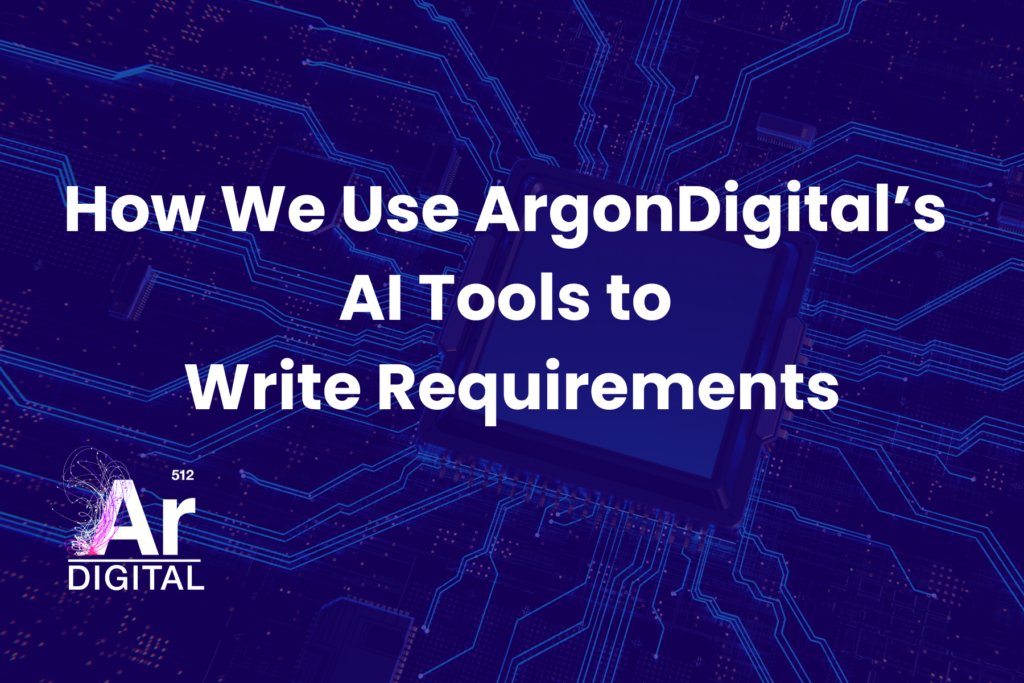At ArgonDigital, we’ve been writing requirements for 22 years. I’ve watched our teams waste hours translating notes into requirements. Now, we’ve cut the nonsense with AI. Our teams can spend time on the important and more interesting product thought work.
Software requirements are the foundation of any development project. Yet, gathering clear, detailed requirements can be challenging. Whether during elicitation meetings or when reverse engineering from a solution’s existing documentation, a solid understanding of requirements is crucial to successful development. With advancements in artificial intelligence (AI), teams can now streamline this process, transforming transcripts or notes into structured requirements. Let’s explore how ArgonDigital’s AI can simplify requirement generation and ensure accuracy, speed, and consistency.
Challenges in Traditional Requirements Gathering
In traditional settings, gathering software requirements often involves extensive meetings and manual note-taking. Team members must translate client needs and goals into requirements, a process prone to information loss, inconsistencies, and human error. Furthermore, manually parsing hours of recorded meetings to extract key requirements is time-consuming, leaving room for oversight. These challenges can create gaps between project goals and outcomes, affecting timelines and customer adoption.
How ArgonDigital’s AI Transforms Requirement Generation from Elicitation Meetings
- Transcribe and Summarize: AI can convert spoken language from meetings into accurate text, providing a reliable transcript. This transcript serves as the foundation for generating software requirements. By automating transcription, AI eliminates the need for manual note-taking, freeing teams to focus on discussions while still ensuring no information is missed.
- Identify Key Points and Actionable Requirements: One of AI’s strengths is its ability to identify patterns and keywords. ArgonDigital’s AI tools can analyze transcripts to pick out critical points, decisions, and stakeholder expectations. For instance, terms related to “user needs,” “functions,” or “system capabilities” are highlighted, helping to pinpoint actionable requirements. AI also captures contextual information, so requirements are not just listed but aligned with the broader project objectives.
- Organize Information into Requirements Format: ArgonDigital’s AI tools can structure extracted information into requirement formats such as user stories, use cases, acceptance criteria, or requirements statements. By automating this process, AI produces drafts of requirements documentation quickly and ensures that the output is organized and follows industry standards. This streamlined approach saves time and reduces the risk of information loss.
Watch This 2 Minute Video to See The AI Write Requirements
Note: if watching on a large screen, click the YoutTube settings and change the Quality from Auto to 1080pHD for better resolution.
Using AI for Reverse Engineering Requirements from Existing Solutions
Reverse engineering requirements from an existing solution involves analyzing documentation and inferred functionality. AI can examine documents, code, or user interfaces to extract detailed requirements, even when previous documentation is missing or incomplete. This allows teams to work backward from an existing solution and map out its functionalities accurately.
AI can go beyond simply listing existing requirements; it can highlight gaps or suggest enhancements based on analyzed patterns. For example, if a current solution is missing certain functionalities commonly found in similar applications, AI can flag these areas as potential enhancements. This capability is particularly useful in modernizing legacy systems or aligning solutions with current standards.
Best Practices for Leveraging AI in Requirement Gathering
To maximize the benefits of AI in requirement gathering:
Combine AI Outputs with Human Oversight: Human validation ensures that the generated requirements align with project goals and client expectations.
Use Iterative Reviews: Regularly review AI-generated requirements to ensure they remain relevant as the project evolves.
Involve Stakeholders in Verification: Present AI-generated requirements to stakeholders early on to confirm accuracy and ensure alignment with their needs.
Train AI Models with Project-Specific Data: Customizing AI tools with project data improves accuracy, especially in niche industries or specialized fields.
Conclusion
AI offers powerful tools to streamline software requirement gathering, whether capturing details from elicitation meetings or reverse engineering requirements from an existing solution. By combining speed, accuracy, and flexibility, AI empowers development teams to work more efficiently and with greater precision.
Ready to try AI for requirement gathering? Reach out to learn more about our AI for gathering requirements. By embracing AI, you’re taking a step toward faster, more reliable, and more accurate software development.




